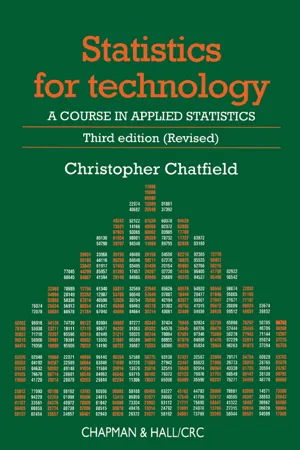
- 384 pages
- English
- ePUB (mobile friendly)
- Available on iOS & Android
About this book
One of the most popular introductory texts in its field, Statistics for Technology: A Course in Applied Studies presents the range of statistical methods commonly used in science, social science, and engineering.The mathematics are simple and straightforward; statistical concepts are explained carefully; and real-life (rather than contrived) examples are used throughout the chapters.Divided into three parts, the Introduction describes some simple methods of summarizing data. Theory examines the basic concepts and theory of statistics. Applications covers the planning and procedures of experiments, quality control, and life testing.Revised throughout, this Third Edition places a higher priority on the role of computers in analysis, and many new references have been incorporated. A new appendix describes general methods of tackling statistical problems, including guidance on literature searching and report writing.
Frequently asked questions
- Essential is ideal for learners and professionals who enjoy exploring a wide range of subjects. Access the Essential Library with 800,000+ trusted titles and best-sellers across business, personal growth, and the humanities. Includes unlimited reading time and Standard Read Aloud voice.
- Complete: Perfect for advanced learners and researchers needing full, unrestricted access. Unlock 1.4M+ books across hundreds of subjects, including academic and specialized titles. The Complete Plan also includes advanced features like Premium Read Aloud and Research Assistant.
Please note we cannot support devices running on iOS 13 and Android 7 or earlier. Learn more about using the app.
Information


104·3 | 158·7 | 193·7 | 201·3 | 206·2 |
227·8 | 249·1 | 307·8 | 311·5 | 329·6 |
358·5 | 364·3 | 370·4 | 380·5 | 394·6 |
426·2 | 434·1 | 552·6 | 594·0 | 691·5 |
Table of contents
- Cover
- Half Title
- Title Page
- Copyright Page
- Table of Contents
- Preface
- Part One Introduction
- Part Two Theory
- Part Three Applications
- Appendix A The relationships between the normal, χ2, t- and F-distributions
- Appendix B Statistical tables
- Appendix C Further reading
- Appendix D Some other topics
- Appendix E Some general comments on tackling statistical problems
- Answers to exercises
- Index